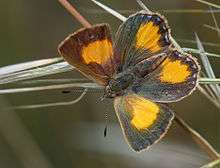Paralucia aurifera
| Bright copper | |
|---|---|
 | |
| Scientific classification | |
| Kingdom: | Animalia |
| Phylum: | Arthropoda |
| Class: | Insecta |
| Order: | Lepidoptera |
| Family: | Lycaenidae |
| Subfamily: | Theclinae |
| Genus: | Paralucia |
| Species: | P. aurifer |
| Binomial name | |
| Paralucia aurifer Blanchard, 1848 | |
Paralucia aurifer, commonly known as the bright copper, is a butterfly belonging to the family Lycaenidae.
Taxonomy
The bright copper was first described by Émile Blanchard in 1848.[1]
Description
The adult bright copper has a wingspan of 25 millimetres (0.98 in).[2]
The flight season is from December to January.[3]
The wings are dull brown on top with gold-orange triangles in the middle of each wing.[3]
Distribution and habitat
It is found in Eastern Australia including New South Wales, eastern Queensland, Victoria, Tasmania and the Australian Capital Territory.[4]
Ecology
The bright copper (Paralucia aurifera) and ant species Anonychomyrma nitidiceps form a complex symbiotic relationship on Bursaria spinosa. Butterflies lay their eggs on the underside of the leaves, and the caterpillars feed on the leaves before pupating in the soil at the foot of the plant. The ants excavate chambers in the soil where the caterpillars sleep and later pupate, and accompany the caterpillars when the latter are feeding. They are thought to feed on the caterpillars' secretions.[5]
Gallery
 Egg, dorsal view
Egg, dorsal view Egg, lateral view
Egg, lateral view Larva
Larva Pupa
Pupa Mounted male
Mounted male Mounted female
Mounted female Male
Male Female
Female
See also
References
- ↑ "Paralucia aurifer". www.funet.fi. Paralucia Waterhouse & Turner, 1905. Retrieved 29 December 2009.
- ↑ "Bright Copper Butterfly Paralucia aurifer". Museum Victoria. Retrieved 19 December 2009.
- 1 2 "Paralucia aurifer". Morwell National Park Online. Retrieved 29 December 2009.
- ↑ Kitching, Roger (1999). Roger Laurence Kitching, ed. Biology of Australian butterflies. CSIRO Publishing. ISBN 9780643050273.
- ↑ Cushman, J. Hall; Rashbrook, Vanessa K.; Beattie, Andrew J. (1994). "Assessing Benefits to Both Participants in a Lycaenid-Ant Association" (PDF). Ecology. 75 (4): 1031–41. doi:10.2307/1939427. JSTOR 1939427.
External links
 Media related to Paralucia aurifer at Wikimedia Commons
Media related to Paralucia aurifer at Wikimedia Commons Data related to Paralucia aurifer at Wikispecies
Data related to Paralucia aurifer at Wikispecies